Cleaner Production of Cementitious Materials Containing Bioaggregates Based on Mussel Shells: A Review
Abstract
1. Introduction
| Country | 2010 | 2011 | 2012 | 2013 | 2014 | 2015 | 2016 | 2017 | 2018 | 2019 | 2020 | 2021 | 2022 |
|---|---|---|---|---|---|---|---|---|---|---|---|---|---|
| China | 2.29 | 2.29 | 2.29 | 2.29 | 2.29 | 2.29 | 2.44 | 2.43 | 2.33 | 2.24 | 2.17 | 2.18 | 2.18 |
| Indonesia | 0.80 | 0.80 | 0.80 | 0.80 | 0.80 | 0.80 | 1.10 | 1.21 | 1.23 | 1.21 | 1.18 | 1.21 | 1.23 |
| Peru | 0.76 | 0.78 | 1.49 | 1.48 | 0.94 | 0.95 | 0.92 | 0.76 | 1.32 | 0.88 | 1.03 | 1.02 | 1.07 |
| United States of America | 0.98 | 1.11 | 1.12 | 1.13 | 1.03 | 1.06 | 1.03 | 1.08 | 1.03 | 1.04 | 0.91 | 0.92 | 0.94 |
| India | 0.37 | 0.56 | 0.64 | 0.66 | 0.59 | 0.77 | 0.86 | 0.85 | 0.78 | 0.79 | 0.80 | 0.83 | 0.85 |
| Japan | 0.69 | 0.80 | 0.70 | 0.81 | 0.68 | 0.69 | 0.68 | 0.69 | 0.70 | 0.68 | 0.68 | 0.75 | 0.78 |
| Vietnam | 0.11 | 0.20 | 0.37 | 0.37 | 0.59 | 0.65 | 0.68 | 0.68 | 0.69 | 0.71 | 0.71 | 0.71 | 0.72 |
| Norway | 0.48 | 0.52 | 0.54 | 0.54 | 0.54 | 0.50 | 0.50 | 0.52 | 0.54 | 0.50 | 0.53 | 0.55 | 0.54 |
| Republic of Korea | 0.24 | 0.40 | 0.38 | 0.34 | 0.30 | 0.30 | 0.34 | 0.35 | 0.39 | 0.38 | 0.43 | 0.44 | 0.46 |
| Morocco | 0.10 | 0.15 | 0.21 | 0.20 | 0.24 | 0.21 | 0.28 | 0.29 | 0.31 | 0.29 | 0.31 | 0.30 | 0.46 |
| Thailand | 0.40 | 0.38 | 0.36 | 0.37 | 0.39 | 0.38 | 0.36 | 0.39 | 0.40 | 0.40 | 0.42 | 0.44 | 0.44 |
| Chile | 0.90 | 0.90 | 0.82 | 0.81 | 0.85 | 0.87 | 0.47 | 0.41 | 0.46 | 0.43 | 0.38 | 0.40 | 0.43 |
| Philippines | 0.29 | 0.29 | 0.30 | 0.36 | 0.37 | 0.38 | 0.38 | 0.41 | 0.36 | 0.36 | 0.38 | 0.38 | 0.39 |
| Malaysia | 0.16 | 0.23 | 0.28 | 0.27 | 0.30 | 0.29 | 0.32 | 0.32 | 0.31 | 0.32 | 0.30 | 0.33 | 0.34 |
| Mexico | 0.26 | 0.25 | 0.26 | 0.27 | 0.32 | 0.32 | 0.28 | 0.29 | 0.29 | 0.31 | 0.29 | 0.32 | 0.31 |
| Iceland | 0.31 | 0.36 | 0.32 | 0.35 | 0.36 | 0.26 | 0.25 | 0.27 | 0.22 | 0.22 | 0.24 | 0.24 | 0.31 |
| Russian Federation | 0.06 | 0.06 | 0.06 | 0.06 | 0.07 | 0.07 | 0.06 | 0.06 | 0.06 | 0.07 | 0.06 | 0.07 | 0.07 |
| France | 0.17 | 0.16 | 0.17 | 0.18 | 0.18 | 0.18 | 0.21 | 0.20 | 0.23 | 0.24 | 0.23 | 0.23 | 0.25 |
| Spain | 0.24 | 0.25 | 0.26 | 0.27 | 0.23 | 0.21 | 0.20 | 0.19 | 0.20 | 0.21 | 0.21 | 0.21 | 0.22 |
| New Zealand | 0.19 | 0.21 | 0.21 | 0.19 | 0.19 | 0.21 | 0.22 | 0.19 | 0.19 | 0.20 | 0.20 | 0.22 | 0.21 |
| Argentina | 0.17 | 0.18 | 0.19 | 0.20 | 0.19 | 0.21 | 0.20 | 0.17 | 0.17 | 0.18 | 0.17 | 0.18 | 0.18 |
| Denmark | 0.40 | 0.37 | 0.40 | 0.33 | 0.23 | 0.16 | 0.19 | 0.17 | 0.14 | 0.16 | 0.17 | 0.17 | 0.17 |
| Brazil | 0.13 | 0.13 | 0.14 | 0.13 | 0.15 | 0.14 | 0.14 | 0.15 | 0.16 | 0.14 | 0.16 | 0.17 | 0.17 |
| Canada | 0.23 | 0.22 | 0.24 | 0.24 | 0.26 | 0.24 | 0.22 | 0.20 | 0.17 | 0.17 | 0.15 | 0.15 | 0.15 |
| Italy | 0.03 | 0.03 | 0.04 | 0.04 | 0.05 | 0.04 | 0.04 | 0.04 | 0.04 | 0.05 | 0.06 | 0.05 | 0.05 |
| Slovenia | 0.03 | 0.03 | 0.03 | 0.03 | 0.03 | 0.05 | 0.05 | 0.05 | 0.05 | 0.06 | 0.04 | 0.04 | 0.04 |
| Others | 2.50 | 1.66 | 1.62 | 1.14 | 2.91 | 2.87 | 2.31 | 2.67 | 2.81 | 2.58 | 2.32 | 2.21 | 1.96 |
| Total | 13.27 | 13.31 | 14.21 | 13.84 | 15.06 | 15.01 | 14.68 | 14.99 | 15.55 | 14.74 | 14.50 | 14.68 | 14.87 |
2. Bioaggregates Obtained from Mussel Shells
2.1. Bibliometric Analysis
2.2. Physical and Chemical Properties of Mussel Shells
| Bioaggregates | Specific Mass (g/cm3) | Specific Gravity | DCM (mm) | FM | Surface Area (mm) | Water Absorption (%) | Moisture Content (%) | Study |
|---|---|---|---|---|---|---|---|---|
| Cockle | 3.03 | 1.32 | - | - | 13.56–23.97 | - | - | [35] |
| Cockle | 2.82 | - | - | - | - | - | 0.15 | [36] |
| Cockle | 2.30 | - | 4.75 | 2.50 | - | - | 0.50 | [6] |
| Cockle | 2.50–2.64 | 2.09 | - | 4.40–4.57 | - | 2.5 | - | [8] |
| Cockle | - | 1.38 | 4.75 | - | - | 5.67 | - | [13] |
| Cockle | 2.52 | 1.39 | 4.00 | - | - | 2.93 | - | [24] |
| Mussel | 3.01 | 1.26 | - | - | 29.87 | - | - | [35] |
| Mussel | 2.57 | - | 4.75 | 3.11 | - | - | 1.73 | [4] |
| Mussel | 2.62–2.73 | - | - | 1.90–5.38 | - | 2.17–4.12 | - | [8] |
| Mussel | 2.40 | - | 5.00 | - | - | 3.52 | - | [16] |
| Mussel | 2.65 | - | 4.00 | 4.64 | - | 2.56 | 0.63 | [7] |
| Mussel | 2.72 | - | 4.00 | 2.21 | - | 3.94 | - | [15] |
| Mussel | 2.59 | 1.57 | 4.00 | 2.15 | - | - | - | [37] |
| Mussel | 2.67 | - | 4.00 | 3.71 | - | 2.22 | - | [19] |
| Oyster | 3.09 | - | - | - | 1.61–58.53 | - | - | [35] |
| Oyster | - | - | - | - | 25.1–46.1 | - | - | [33] |
| Oyster | 2.65 | - | - | - | - | - | 0.36 | [36] |
| Oyster | 1.85–2.48 | - | - | 2.00–6.50 | - | 2.9–9.2 | - | [8] |
| Oyster | 2.42 | - | 4.75 | - | - | - | - | [38] |
| Oyster | 2.48 | 5.00 | 2.80 | - | 2.90 | 0.57 | [39] | |
| Oyster | 2.10 | 1.05 | 4.75 | 2.00 | - | 7.66 | - | [40] |
| Oyster | - | 1.85 | - | 2.8 | - | 9.2 | - | [41] |
| Oyster | 2.58 | - | 4.75 | 3.13 | - | 3.54 | - | [42] |
| Bioaggregates | CaCO3 | Na2O | SO3 | MgCO3 | SiO2 | Al2O3 | SO4 | Other | Study |
|---|---|---|---|---|---|---|---|---|---|
| Cockle | 96.85 | 0.42 | 0.11 | 0.04 | 0.94 | 0.15 | 0.05 | 1.44 | [6] |
| Cockle | 97.13 | 0.37 | 0.13 | 0.02 | 0.98 | 0.17 | 0.07 | 1.13 | [36] |
| Mussel | 95.09 | 0.35 | 0.18 | 0.21 | 1.12 | <0.01 | - | 3.04 | [7] |
| Mussel | 89.46 | - | 0.57 | - | 1.26 | - | - | 0.07 | [4] |
| Mussel | 96.80 | 0.27 | 0.34 | 0.05 | 0.55 | 0.20 | 0.11 | 1.68 | [48] |
| Mussel | 95.60 | 0.44 | 0.34 | 0.03 | 0.73 | 0.13 | 0.11 | 2.62 | [36] |
| Mussel | 98.64 | 0.42 | 0.52 | 0.10 | - | - | - | 0.32 | [49] |
| Oyster | 95.70 | 0.19 | 0.73 | 0.42 | 1.01 | 0.14 | 0.32 | 1.49 | [48] |
| Oyster | 96.80 | 0.23 | 0.75 | 0.46 | 1.01 | 0.14 | 0.43 | 0.18 | [36] |
| Oyster | 89.56 | 0.98 | 0.72 | 0.65 | 4.04 | 0.42 | - | 3.63 | [50] |
2.3. Applications of Mussels Shells: Life Cycle Analysis (LCA)
2.4. Bioaggregates Applied to Cementitious Materials
2.4.1. Influence of Bioaggregate Particle Size
2.4.2. Influence of the Specific Mass of the Bioaggregate
2.4.3. Influence of Bioaggregate Morphology
2.4.4. Influence of the Chemical Composition of the Bioaggregate
2.4.5. Workability and Rheological Properties of Cementitious Materials Containing Bioaggregates
2.4.6. Water Absorption, Porosity, and Capillarity of Cementitious Materials Containing Bioaggregates
2.4.7. Mechanical Strength of Cementitious Materials Containing Bioaggregates
| Bioaggregates | % Replacement | Compresive Strenght (MPa) | Flexural Strength (MPa) | Tensile Strength (MPa) | Modulus of Elasticity (MPa) | Study |
|---|---|---|---|---|---|---|
| Cockle | 0 | 25.75 | - | 2.72 | - | [6] |
| 10 | 22.98 | - | 2.10 | - | ||
| 20 | 20.21 | - | 2.00 | - | ||
| 30 | 17.44 | - | 2.10 | - | ||
| 40 | 17.06 | - | 2.25 | - | ||
| 50 | 15.93 | - | 2.40 | - | ||
| 60 | 13.19 | - | 1.64 | - | ||
| 100 | 11.69 | - | 1.73 | - | ||
| Cockle | 0 | 16.50 | - | 2.50 | - | [97] |
| 10 | 14.00 | - | 2.08 | - | ||
| 20 | 9.80 | - | 1.78 | - | ||
| Cockle | 0 | 21.70 | - | 2.82 | - | [103] |
| 20 | 21.20 | - | 2.60 | - | ||
| 20 | 18.00 | - | 2.30 | - | ||
| 40 | 15.30 | - | 2.12 | - | ||
| Cockle | 0 | 40.50 | 8.00 | - | 23.60 | [104] |
| 50 | 39.00 | 6.40 | - | 22.50 | ||
| 100 | 36.00 | 6.10 | - | 21.20 | ||
| Mussel | 0 | 29.64 | - | 2.40 | 29.00 | [19] |
| 25 | 20.19 | - | 1.70 | 24.00 | ||
| 50 | 9.34 | - | 1.35 | 17.50 | ||
| 75 | 7.99 | - | 1.10 | 14.50 | ||
| 100 | 8.29 | - | 1.05 | 13.00 | ||
| Mussel | 0 | 38.00 | - | 3.05 | - | [16] |
| 15 | 40.50 | - | 3.10 | - | ||
| 30 | 36.50 | - | 2.90 | - | ||
| Mussel | 0 | 62.00 | - | 5.80 | - | [90] |
| 30 | 41.50 | - | 3.40 | - | ||
| Mussel | 0 | 31.30 | 2.79 | - | 28.50 | [93] |
| 10 | 29.20 | 2.50 | - | 26.70 | ||
| Mussel | 0 | 36.20 | 4.50 | 4.25 | 25.00 | [50] |
| 5 | 35.80 | 4.60 | 4.30 | 23.00 | ||
| Oyster | 0 | 29.30 | - | - | 33.50 | [39] |
| 10 | 29.10 | - | - | 31.20 | ||
| 20 | 29.60 | - | - | 29.90 | ||
| Oyster | 0 | 40.00 | - | 3.20 | 33.00 | [105] |
| 5 | 45.00 | - | 2.90 | 32.50 | ||
| 10 | 42.00 | - | 2.88 | 31.00 | ||
| 20 | 40.50 | - | 2.82 | 29.50 | ||
| Oyster | 0 | 33.00 | - | 3.00 | - | [44] |
| 5 | 33.80 | - | 3.10 | - | ||
| 20 | 32.70 | - | 3.20 | - | ||
| 40 | 30.30 | - | 2.85 | - | ||
| 60 | 32.50 | - | 2.80 | - | ||
| Oyster | 0 | 29.70 | 3.20 | - | - | [41] |
| 30 | 24.80 | 2.75 | - | - | ||
| 50 | 22.65 | 2.30 | - | - |
2.4.8. Thermal Insulation of Cementitious Materials Containing Bioaggregates
3. Conclusions and Suggestions for Future Work
- -
- Mussel shells are waste found in different countries around the world, such as China, Indonesia, Peru, and the United States of America, with high levels of generation with values of approximately 15 million tons/year in 2023. These shells are generally discarded irregularly or in landfills. The high level of waste generation demonstrates an alert for alternative applications, such as the study of bioaggregates.
- -
- Bioaggregates produced from mussel shells and similar materials have potential for application in concrete and mortars due to their chemical composition, predominantly based on CaCO3 in the form of calcite or aragonite, compatible with limestone aggregates and chemically inert.
- -
- Challenges from a chemical point of view are related to the presence of organic impurities, especially in the chitin layer in the external shell, and the presence of chlorides and sulfates, which can delay the setting of the cement or impair the adhesion of the aggregate with the cement paste. Research shows that carrying out simple cleaning treatments, such as washing in running water and drying in ovens at temperatures of 100 °C, are sufficient to remove impurities and enable the application of the material as a bioaggregate.
- -
- Regarding physical properties, it is observed that bioaggregates have a specific mass similar to conventional aggregates and can be used in different particle sizes, with great variation in MF and DMC. However, there is a greater potential for application as fine aggregate, as these effects are less detrimental to the compressive strength of cementitious materials.
- -
- The morphology of bioaggregates is complex, but the presence of lamellar, irregular, highly porous, and flat particles predominate. This particle pattern harms the transition zone between paste and aggregate, promoting entrained air, porosity, and a reduction in strength. However, it is worth highlighting that the transition zone is less complex than that noted using recycled construction and demolition aggregates, for example. This is an advantage when applying the material.
- -
- From a properties point of view, it is observed that the use of bioaggregates in concrete and mortar has a tendency to worsen workability, increase water absorption and porosity, reduce density, and cause damage to mechanical properties. On the other hand, there is a tendency to reduce thermal conductivity, suggesting an improvement in insulation properties. This pattern is justified by the high water absorption of the bioaggregate due to the presence of irregular, lamellar, and porous particles, which impair adhesion to the cement paste. The presence of organic impurities, chlorides, and other factors increase in the viscosity of cementitious materials in the fresh state.
- -
- However, several authors demonstrate that the use of lower levels of bioaggregate, generally up to 25%, does not harm the mechanical properties of concrete and mortars, emerging as an eco-friendly solution for disposing of mussel shell waste, for example. Other possible applications include porous or permeable concrete; concrete and light mortars; material for covering, sealing or laying blocks; or even as mortars for thermal and acoustic insulation. In this way, viable solutions for the use of mussel shell bioaggregates in cementitious materials are observed.
- -
- Other possible applications for mussel shells involve the use of the material as an additive to animal feed, retention filter, establishment of a fertilizer, or controlling eutrophication in ponds and water treatment systems. However, none of these applications have a large scale ability to dispose of waste from mussel shells. Applications as bioaggregates in concrete and mortar make it possible to correctly recycle this waste, enabling the correct application of LCA.
- -
- Characterization of mussel shell bioaggregates, using techniques such as Los Angeles abrasion tests, aggregate strength, tenacity tests, and/or packing compactness tests.
- -
- Analysis of the efficiency of the mussel shell cleaning treatment through washing and drying cycles, heating the waste, or applying jet and pressure washing.
- -
- Rheological tests with concrete and mortars containing mussel shell bioaggregates and similar materials; assessments of incorporated air, water retention, and rheology using dropping ball or squeeze flow test; and rheology analysis using viscometers.
- -
- Tests that evaluate the influence of bioaggregates on the reactivity of Portland cement, such as calorimetry tests and the definition of setting times, together with complementary analyzes of X-ray diffraction, scanning electron microscopy, or thermal analyses, aiming to explore the phases formed or altered during cement hydration.
- -
- Additional tests on thermal, acoustic, and electrical insulation of mortars and concrete with bioaggregates, as there is potential to improve these properties with the use of mussel shells.
- -
- Assessments of other important mechanical parameters, such as modulus of elasticity and tensile strength in flexion or diametrical compression to demonstrate the impact of bioaggregates on other relevant properties.
- -
- Verify the influence of the use of additional cementitious materials, such as blast furnace slag and pozzolans, on the properties of concrete and mortars produced with mussel shells.
- -
- Durability analysis of concrete and mortars containing mussel shell bioaggregates using carbonation tests, chloride and sulfate attack, salt spray, freeze and thaw cycles, and/or fire simulation.
- -
- Analysis of the pore structure and porosity of concrete and mortars containing bioaggregates with mussel shells and similar materials using tests such as mercury intrusion porosometry or microtomography of concrete.
- -
- Non-destructive tests on concrete and mortars containing bioaggregates using sclerometry, ultrasonic pulse, and electrical resistivity tests.
- -
- Theoretical and experimental modeling of reinforced concrete elements with bioaggregates through the analysis of beams, pillars, and slabs on a reduced scale.
- -
- Economic analysis of concrete and mortar containing mussel shell bioaggregates or similar materials.
- -
- Environmental characterization tests of mussel shells and concrete and mortars containing waste, through leaching and solubilization.
Author Contributions
Funding
Data Availability Statement
Conflicts of Interest
References
- Marvila, M.; de Matos, P.; Rodríguez, E.; Monteiro, S.N.; de Azevedo, A.R.G. Recycled Aggregate: A Viable Solution for Sustainable Concrete Production. Materials 2022, 15, 5276. [Google Scholar] [CrossRef] [PubMed]
- Monteiro, G.P.; Marvila, M.T.; Pedroti, L.G.; de Brito, J.; de Azevedo, A.R. Evaluation of coating mortars with addition of açaí seed (Euterpe oleracea Mart.) in different processing conditions. J. Build. Eng. 2023, 83, 108459. [Google Scholar] [CrossRef]
- Beh, J.H.; Yew, M.C.; Lee, F.W.; Saw, L.H.; Lim, S.K. Performance of surface modification on bio-based aggregate for high strength lightweight concrete. Case Stud. Constr. Mater. 2022, 16, e00910. [Google Scholar] [CrossRef]
- Artismo, T.V.; Braga, F.d.O.; Rocha, C.A.A. Physical-mechanical behavior of workable mortars with Perna perna mussel shell as fine aggregate. Constr. Build. Mater. 2024, 418, 135411. [Google Scholar] [CrossRef]
- Awoyera, P.O.; Thomas, C.; Kirgiz, M.S. The Structural Integrity of Recycled Aggregate Concrete Produced with Fillers and Pozzolans; Elsevier: Amsterdam, The Netherlands, 2022. [Google Scholar]
- Bamigboye, G.O.; Okechukwu, U.E.; Olukanni, D.O.; Bassey, D.E.; Okorie, U.E.; Adebesin, J.; Jolayemi, K.J. Effective Economic Combination of Waste Seashell and River Sand as Fine Aggregate in Green Concrete. Sustainability 2022, 14, 12822. [Google Scholar] [CrossRef]
- Martínez-García, C.; González-Fonteboa, B.; Carro-López, D.; Martínez-Abella, F. Impact of mussel shell aggregates on air lime mortars. Pore structure and carbonation. J. Clean. Prod. 2019, 215, 650–668. [Google Scholar] [CrossRef]
- Eziefula, U.G.; Ezeh, J.C.; Eziefula, B.I. Properties of seashell aggregate concrete: A review. Constr. Build. Mater. 2018, 192, 287–300. [Google Scholar] [CrossRef]
- Saberian, M.; Li, J.; Cameron, D. Effect of Crushed Glass on Behavior of Crushed Recycled Pavement Materials Together with Crumb Rubber for Making a Clean Green Base and Subbase. J. Mater. Civ. Eng. 2019, 31, 04019108. [Google Scholar] [CrossRef]
- Ibrahim, H.A.; Goh, Y.; Ng, Z.A.; Yap, S.P.; Mo, K.H.; Yuen, C.W.; Abutaha, F. Hydraulic and strength characteristics of pervious concrete containing a high volume of construction and demolition waste as aggregates. Constr. Build. Mater. 2020, 253, 119251. [Google Scholar] [CrossRef]
- Mohammed, A.A.; Rahim, A.A.F. Experimental behavior and analysis of high strength concrete beams reinforced with PET waste fiber. Constr. Build. Mater. 2020, 244, 118350. [Google Scholar] [CrossRef]
- FAO. The State of World Fisheries and Aquaculture 2022; FAO: Rome, Italy, 2022. [Google Scholar] [CrossRef]
- Ogundipe, K.E.; Ogunbayo, B.F.; Olofinnade, O.M.; Amusan, L.M.; Aigbavboa, C.O. Affordable housing issue: Experimental investigation on properties of eco-friendly lightweight concrete produced from incorporating periwinkle and palm kernel shells. Results Eng. 2020, 9, 100193. [Google Scholar] [CrossRef]
- Nepal, D.; Kang, S.; Adstedt, K.M.; Kanhaiya, K.; Bockstaller, M.R.; Brinson, L.C.; Buehler, M.J.; Coveney, P.V.; Dayal, K.; El-Awady, J.A.; et al. Hierarchically structured bioinspired nanocomposites. Nat. Mater. 2022, 22, 18–35. [Google Scholar] [CrossRef]
- Martínez-García, C.; González-Fonteboa, B.; Carro-López, D.; Martínez-Abella, F. Design and properties of cement coating with mussel shell fine aggregate. Constr. Build. Mater. 2019, 215, 494–507. [Google Scholar] [CrossRef]
- Chen, B.; Peng, L.; Zhong, H.; Zhao, Y.; Meng, T.; Zhang, B. Improving the mechanical properties of mussel shell aggregate concrete by aggregate modification and mixture design. Case Stud. Constr. Mater. 2023, 18, e02017. [Google Scholar] [CrossRef]
- Cardoso, A.d.S.; Rabbani, E.R.K.; Delmiro, T.D.; Mocock, J.F.B.; Silva, S.P.R.d.; Filippelli, G.; Macedo, J.V.d.S.; Monteiro, E.C.B. Mollusk shell waste: Alternatives for reuse in construction. Int. J. Environ. Waste Manag. 2023, 31, 61–80. [Google Scholar] [CrossRef]
- Melais, F.Z.; Dorbani, K.; Arabi, N.; Achoura, D. The use of marine seashells as aggregates in pervious concretes. Cem. Wapno Beton 2023, 28, 76–91. [Google Scholar] [CrossRef]
- Martínez-García, C.; González-Fonteboa, B.; Martínez-Abella, F.; López, D.C. Performance of mussel shell as aggregate in plain concrete. Constr. Build. Mater. 2017, 139, 570–583. [Google Scholar] [CrossRef]
- Menezes, R.C.; Marques, S.K.J.; de Souza, R.F.M. Development of masonry mortar with discarded sururu shells from the Mundau-Manguaba lagoon estuary complex, Brazil. Clean. Eng. Technol. 2022, 8, 100502. [Google Scholar] [CrossRef]
- Martínez-García, C.; González-Fonteboa, B.; Carro-López, D.; Pérez-Ordóñez, J.L.; Martínez-Abella, F. Building Engineering Facing the Challenges of the 21st Century; Springer Nature: Singapore, 2023. [Google Scholar] [CrossRef]
- Naik, A.; Hayes, M. Bioprocessing of mussel by-products for value added ingredients. Trends Food Sci. Technol. 2019, 92, 111–121. [Google Scholar] [CrossRef]
- Hasan, K.; Karim, A.; Islam, T.; Bin Ali, M.; Rahman, T.; Rahman, M.; Yahaya, F.M. A review of the mechanical properties and durability of concrete containing recycled seashells as a partial cement replacement. J. Mater. Cycles Waste Manag. 2023, 25, 3192–3216. [Google Scholar] [CrossRef]
- Nguyen, D.H.; Boutouil, M.; Sebaibi, N.; Baraud, F.; Leleyter, L. Durability of pervious concrete using crushed seashells. Constr. Build. Mater. 2017, 135, 137–150. [Google Scholar] [CrossRef]
- Iribarren, D.; Moreira, M.T.; Feijoo, G. Implementing by-product management into the Life Cycle Assessment of the mussel sector. Resour. Conserv. Recycl. 2010, 54, 1219–1230. [Google Scholar] [CrossRef]
- da Silva, E.G.; Castilho-Barros, L.; Henriques, M.B. Economic feasibility of integrated multi-trophic aquaculture (mussel Perna perna, scallop Nodipecten nodosus and seaweed Kappaphycus alvarezii) in Southeast Brazil: A small-scale aquaculture farm model. Aquaculture 2022, 552, 738031. [Google Scholar] [CrossRef]
- Skelton, B.M.; South, P.M.; Jeffs, A.G. Inefficiency of conversion of seed into market-ready mussels in New Zealand’s Greenshell™ mussel (Perna canaliculus) industry. Aquaculture 2022, 560, 738584. [Google Scholar] [CrossRef]
- The European Commission. The EU Fish Markey, 1st ed.; The European Commission: Luxembourg, 2023. [Google Scholar]
- Veríssimo, N.V.; Mussagy, C.U.; Oshiro, A.A.; Mendonça, C.M.N.; Santos-Ebinuma, V.d.C.; Pessoa, A.; Oliveira, R.P.d.S.; Pereira, J.F.B. From green to blue economy: Marine biorefineries for a sustainable ocean-based economy. Green Chem. 2021, 23, 9377–9400. [Google Scholar] [CrossRef]
- Águila-Almanza, E.; Hernández-Cocoletzi, H.; Rubio-Rosas, E.; Calleja-González, M.; Lim, H.R.; Khoo, K.S.; Singh, V.; Maldonado-Montiel, J.; Show, P.L. Recuperation and characterization of calcium carbonate from residual oyster and clamshells and their incorporation into a residential finish. Chemosphere 2022, 288, 132550. [Google Scholar] [CrossRef] [PubMed]
- González-Caro, Á.; Merino-Lechuga, A.M.; Fernández-Ledesma, E.; Fernández-Rodríguez, J.M.; Jiménez, J.R.; Suescum-Morales, D. The Effect of Acanthocardia tuberculata Shell Powder as Filler on the Performance of Self-Compacting Mortar. Materials 2023, 16, 1734. [Google Scholar] [CrossRef] [PubMed]
- Jeong, I.; Woo, H.-E.; Lee, I.-C.; Kim, J. Evaluation of Nutrients Removal using Pyrolyzed Oyster Shells. J. Korean Soc. Mar. Environ. Saf. 2019, 25, 906–913. [Google Scholar] [CrossRef]
- Ez-Zaki, H.; Diouri, A.; Kamali-Bernard, S.; Sassi, O. Composite cement mortars based on marine sediments and oyster shell powder. Mater. Constr. 2016, 66, e080. [Google Scholar] [CrossRef]
- Kirthika, S.; Singh, S. Durability studies on recycled fine aggregate concrete. Constr. Build. Mater. 2020, 250, 118850. [Google Scholar] [CrossRef]
- Bamigboye, G.O.; Nworgu, A.T.; Odetoyan, A.O.; Kareem, M.; Enabulele, D.O.; Bassey, D.E. Sustainable use of seashells as binder in concrete production: Prospect and challenges. J. Build. Eng. 2020, 34, 101864. [Google Scholar] [CrossRef]
- Lertwattanaruk, P.; Makul, N.; Siripattarapravat, C. Utilization of ground waste seashells in cement mortars for masonry and plastering. J. Environ. Manag. 2012, 111, 133–141. [Google Scholar] [CrossRef] [PubMed]
- Barbachi, M.; Imad, A.; Jeffali, F.; Boudjellal, K.; Bouabaz, M. Physical characterization of sea shell for a concrete formulation. J. Mater. Environ. Sci. 2017, 8, 332–337. [Google Scholar]
- Yoon, H.; Park, S.; Lee, K.; Park, J. Oyster Shell as Substitute for Aggregate in Mortar. Waste Manag. Res. J. Sustain. Circ. Econ. 2004, 22, 158–170. [Google Scholar] [CrossRef] [PubMed]
- Yang, E.-I.; Kim, M.-Y.; Park, H.-G.; Yi, S.-T. Effect of partial replacement of sand with dry oyster shell on the long-term performance of concrete. Constr. Build. Mater. 2009, 24, 758–765. [Google Scholar] [CrossRef]
- Wang, H.-Y.; Kuo, W.-T.; Lin, C.-C.; Po-Yo, C. Study of the material properties of fly ash added to oyster cement mortar. Constr. Build. Mater. 2013, 41, 532–537. [Google Scholar] [CrossRef]
- Eo, S.-H.; Yi, S.-T. Effect of oyster shell as an aggregate replacement on the characteristics of concrete. Mag. Concr. Res. 2015, 67, 833–842. [Google Scholar] [CrossRef]
- Panda, K.C.; Behera, S.; Jena, S. Effect of rice husk ash on mechanical properties of concrete containing crushed seashell as fine aggregate. Mater. Today Proc. 2020, 32, 838–843. [Google Scholar] [CrossRef]
- Choi, S.Y.; Lee, W.J.; Yang, E.I. Estimating compressive strength of early age frost damaged recycled aggregate concrete using nondestructive evaluation techniques. Arch. Civ. Mech. Eng. 2023, 23, 235. [Google Scholar] [CrossRef]
- Varhen, C.; Carrillo, S.; Ruiz, G. Experimental investigation of Peruvian scallop used as fine aggregate in concrete. Constr. Build. Mater. 2017, 136, 533–540. [Google Scholar] [CrossRef]
- Martínez-García, C.; González-Fonteboa, B.; Carro-López, D.; Pérez-Ordóñez, J.L. Assessment of mussel shells building solutions: A real-scale application. J. Build. Eng. 2021, 44, 102635. [Google Scholar] [CrossRef]
- Mo, K.H.; Alengaram, U.J.; Jumaat, M.Z.; Lee, S.C.; Goh, W.I.; Yuen, C.W. Recycling of seashell waste in concrete: A review. Constr. Build. Mater. 2018, 162, 751–764. [Google Scholar] [CrossRef]
- Marin, F.; Le Roy, N.; Marie, B. The formation and mineralization of mollusk shell. Front. Biosci. 2012, S4, 1099–1125. [Google Scholar] [CrossRef] [PubMed]
- Mo, K.H.; Alengaram, U.J.; Jumaat, M.Z.; Yap, S.P.; Lee, S.C. Green concrete partially comprised of farming waste residues: A review. J. Clean. Prod. 2016, 117, 122–138. [Google Scholar] [CrossRef]
- Souidi, A.; Maaloufa, Y.; Amazal, M.; Atigui, M.; Oubeddou, S.; Mounir, S.; Idoum, A.; Aharoune, A. The effect of mussel shell powder on the thermal and mechanical properties of plaster. Constr. Build. Mater. 2024, 416, 135142. [Google Scholar] [CrossRef]
- Tayeh, B.A.; Hasaniyah, M.W.; Zeyad, A.; Yusuf, M.O. Properties of concrete containing recycled seashells as cement partial replacement: A review. J. Clean. Prod. 2019, 237, 117723. [Google Scholar] [CrossRef]
- Choi, S.H.; Lee, J.-H.; Yoo, J.; Park, J.H.; Bae, J.-S.; Park, C.Y. Toward transformation of bivalve shell wastes into high value-added and sustainable products in South Korea: A review. J. Ind. Eng. Chem. 2024, 129, 38–52. [Google Scholar] [CrossRef]
- Guan, Y.; Chen, R.; Sun, G.; Liu, Q.; Liu, J.; Yu, J.; Lin, C.; Duan, J.; Wang, J. The mussel-inspired micro-nano structure for antifouling:A flowering tree. J. Colloid Interface Sci. 2021, 603, 307–318. [Google Scholar] [CrossRef] [PubMed]
- Srichanachaichok, W.; Pissuwan, D. Micro/Nano Structural Investigation and Characterization of Mussel Shell Waste in Thailand as a Feasible Bioresource of CaO. Materials 2023, 16, 805. [Google Scholar] [CrossRef]
- Soltanzadeh, F.; Emam-Jomeh, M.; Edalat-Behbahani, A.; Soltan-Zadeh, Z. Development and characterization of blended cements containing seashell powder. Constr. Build. Mater. 2018, 161, 292–304. [Google Scholar] [CrossRef]
- Gong, Y.; Shao, C.; Wang, Z.; Liu, R.; Zhang, Q.; Ren, Z.; Zhu, Z.; Zhao, D.; Bai, J.; Tian, J.; et al. Feasibility study on the preparation of ternary cement with calcined slag powder and seashell powder as supplementary cementitious materials. Constr. Build. Mater. 2023, 409, 134223. [Google Scholar] [CrossRef]
- Wang, J.; Liu, E.; Li, L. Characterization on the recycling of waste seashells with Portland cement towards sustainable cementitious materials. J. Clean. Prod. 2019, 220, 235–252. [Google Scholar] [CrossRef]
- Avató, J.L.; Mannheim, V. Life Cycle Assessment Model of a Catering Product: Comparing Environmental Impacts for Different End-of-Life Scenarios. Energies 2022, 15, 5423. [Google Scholar] [CrossRef]
- Kwon, G.; Bhatnagar, A.; Wang, H.; Kwon, E.E.; Song, H. A review of recent advancements in utilization of biomass and industrial wastes into engineered biochar. J. Hazard. Mater. 2020, 400, 123242. [Google Scholar] [CrossRef] [PubMed]
- Maury-Ramírez, A.; Illera-Perozo, D.; Mesa, J.A. Circular Economy in the Construction Sector: A Case Study of Santiago de Cali (Colombia). Sustainability 2022, 14, 1923. [Google Scholar] [CrossRef]
- Fulgêncio, E.B.G.A.; de Medeiros, F.K.; Cartaxo, J.M.; Dutra, R.P.S.; Macedo, D.A.; Campos, L.F.A. Estudo da incorporação de pó de concha de marisco em massa de porcelanato. Artic. Ceram. 2018, 64, 381–387. [Google Scholar] [CrossRef]
- Paz-Ferreiro, J.; Baez-Bernal, D.; Insúa, J.C.; Pomar, M.G. Effects of mussel shell addition on the chemical and biological properties of a Cambisol. Chemosphere 2012, 86, 1117–1121. [Google Scholar] [CrossRef] [PubMed]
- Kojima, Y.; Takemura, T.; Tanaka, A. Composting treatment and fertilizer properties of golden mussel (Limnoperna fortunei) mixed with dairy cow manure. Paddy Water Environ. 2024. [Google Scholar] [CrossRef]
- Paredes, E.; Gallego, V. The Importance of Developing and Standardizing Gamete, Embryo and Larvae Handling in Aquatic Animals. Animals 2023, 13, 270. [Google Scholar] [CrossRef]
- Tamburini, E.; Fano, E.A.; Castaldelli, G.; Turolla, E. Life Cycle Assessment of Oyster Farming in the Po Delta, Northern Italy. Resources 2019, 8, 170. [Google Scholar] [CrossRef]
- Bukhtiyarova, M. A review on effect of synthesis conditions on the formation of layered double hydroxides. J. Solid State Chem. 2018, 269, 494–506. [Google Scholar] [CrossRef]
- Qiu, S.; Zhao, D.; Feng, Y.; Li, M.; Liang, X.; Zhang, L.; Luo, Y.; Zhang, K.; Wang, F. Adsorption performance and mechanism of Ca–Al-LDHs prepared by oyster shell and pop can for phosphate from aqueous solutions. J. Environ. Manag. 2021, 303, 114235. [Google Scholar] [CrossRef] [PubMed]
- Jeong, I.; Kim, K. Evaluation of compressive strength and phosphate fixation characteristics of wastewater filter media using coal bottom ash and oyster shells. J. Environ. Manag. 2023, 341, 118057. [Google Scholar] [CrossRef] [PubMed]
- Jeong, I.; Kim, K. Utilizing a granulated coal bottom ash and oyster shells for nutrient removal in eutrophic sediments. Mar. Pollut. Bull. 2022, 177, 113549. [Google Scholar] [CrossRef] [PubMed]
- Alidoust, D.; Kawahigashi, M.; Yoshizawa, S.; Sumida, H.; Watanabe, M. Mechanism of cadmium biosorption from aqueous solutions using calcined oyster shells. J. Environ. Manag. 2014, 150, 103–110. [Google Scholar] [CrossRef] [PubMed]
- Wu, Q.; Chen, J.; Clark, M.; Yu, Y. Adsorption of copper to different biogenic oyster shell structures. Appl. Surf. Sci. 2014, 311, 264–272. [Google Scholar] [CrossRef]
- Gedik, K.; Eryaşar, A.R.; Gözler, A.M. The microplastic pattern of wild-caught Mediterranean mussels from the Marmara Sea. Mar. Pollut. Bull. 2022, 175, 113331. [Google Scholar] [CrossRef] [PubMed]
- Green, K.M.; Spalding, A.K.; Ward, M.; Levine, A.; Wolters, E.A.; Hamilton, S.L.; Rice, L. Oregon shellfish farmers: Perceptions of stressors, adaptive strategies, and policy linkages. Ocean Coast. Manag. 2023, 234, 106475. [Google Scholar] [CrossRef]
- Mezzelani, M.; Fattorini, D.; Gorbi, S.; Nigro, M.; Regoli, F. Human pharmaceuticals in marine mussels: Evidence of sneaky environmental hazard along Italian coasts. Mar. Environ. Res. 2020, 162, 105137. [Google Scholar] [CrossRef]
- DiLoreto, Z.; Weber, P.; Weisener, C. Solid phase characterization and metal deportment in a mussel shell bioreactor for the treatment of AMD, Stockton Coal Mine, New Zealand. Appl. Geochem. 2016, 67, 133–143. [Google Scholar] [CrossRef]
- Caroscio, L.; De Pascale, B.; Tataranni, P.; Chiavetta, C.; Lantieri, C.; Bonoli, A. Preliminary study on the application of waste bivalve shells as biofiller for the production of asphalt concrete. Clean. Eng. Technol. 2024, 20, 100743. [Google Scholar] [CrossRef]
- Hasnaoui, A.; Bourguiba, A.; El Mendili, Y.; Sebaibi, N.; Boutouil, M. A preliminary investigation of a novel mortar based on alkali-activated seashell waste powder. Powder Technol. 2021, 389, 471–481. [Google Scholar] [CrossRef]
- Rupasinghe, M.; Nicolas, R.S.; Lanham, B.S.; Morris, R.L. Sustainable oyster shell incorporated artificial reef concrete for living shorelines. Constr. Build. Mater. 2024, 410, 134217. [Google Scholar] [CrossRef]
- Nedeljković, M.; Visser, J.; Šavija, B.; Valcke, S.; Schlangen, E. Use of fine recycled concrete aggregates in concrete: A critical review. J. Build. Eng. 2021, 38, 102196. [Google Scholar] [CrossRef]
- Martínez-García, C.; González-Fonteboa, B.; Carro-López, D.; Martínez-Abella, F. Mussel shell mortars durability: Study of aggregate replacement limit. J. Build. Eng. 2024, 82, 108239. [Google Scholar] [CrossRef]
- Revilla-Cuesta, V.; Evangelista, L.; de Brito, J.; Ortega-López, V.; Manso, J.M. Effect of the maturity of recycled aggregates on the mechanical properties and autogenous and drying shrinkage of high-performance concrete. Constr. Build. Mater. 2021, 299, 124001. [Google Scholar] [CrossRef]
- Bendimerad, A.Z.; Delsaute, B.; Rozière, E.; Staquet, S.; Loukili, A. Advanced techniques for the study of shrinkage-induced cracking of concrete with recycled aggregates at early age. Constr. Build. Mater. 2020, 233, 117340. [Google Scholar] [CrossRef]
- Santos, A.R.; Veiga, M.D.R.; Silva, A.S.; de Brito, J.; Álvarez, J.I. Evolution of the microstructure of lime based mortars and influence on the mechanical behaviour: The role of the aggregates. Constr. Build. Mater. 2018, 187, 907–922. [Google Scholar] [CrossRef]
- Martínez-García, C.; González-Fonteboa, B.; Carro-López, D.; Pérez-Ordóñez, J.L. Mussel shells: A canning industry by-product converted into a bio-based insulation material. J. Clean. Prod. 2020, 269, 122343. [Google Scholar] [CrossRef]
- Marvila, M.T.; de Azevedo, A.R.G.; Ferreira, R.L.S.; Vieira, C.M.F.; de Brito, J.; Adesina, A. Validation of alternative methodologies by using capillarity in the determination of porosity parameters of cement-lime mortars. Mater. Struct. 2022, 55, 19. [Google Scholar] [CrossRef]
- Marvila, M.T.; Azevedo, A.R.G.; Monteiro, S.N. Verification of the application potential of the mathematical models of lyse, abrams and molinari in mortars based on cement and lime. J. Mater. Res. Technol. 2020, 9, 7327–7334. [Google Scholar] [CrossRef]
- Marvila, M.T.; de Azevedo, A.R.G.; de Matos, P.R.; Monteiro, S.N.; Vieira, C.M.F. Materials for Production of High and Ultra-High Performance Concrete: Review and Perspective of Possible Novel Materials. Materials 2021, 14, 4304. [Google Scholar] [CrossRef] [PubMed]
- Qu, K.; Chen, X.; Wang, Y.; Calautit, J.; Riffat, S.; Cui, X. Comprehensive energy, economic and thermal comfort assessments for the passive energy retrofit of historical buildings—A case study of a late nineteenth-century Victorian house renovation in the UK. Energy 2020, 220, 119646. [Google Scholar] [CrossRef]
- Oh, S.-E.; Chung, S.-Y.; Kim, K.; Han, S.-H. Comparative analysis of the effects of waste shell aggregates on the material properties of cement mortars. Constr. Build. Mater. 2024, 412, 134887. [Google Scholar] [CrossRef]
- Lv, M.; An, X.; Bai, H.; Li, P.; Zhang, J. Influence of the fine aggregate particle packing effects on the paste rheological thresholds of self-compacting concrete. Constr. Build. Mater. 2023, 397, 132379. [Google Scholar] [CrossRef]
- Chen, B.; Peng, L.; Zhong, H.; Zhao, Y.; Meng, T.; Zhang, B. Synergetic recycling of recycled concrete aggregate and waste mussel shell in concrete: Mechanical properties, durability and microstructure. Constr. Build. Mater. 2023, 371, 130825. [Google Scholar] [CrossRef]
- Olivia, M.; Oktaviani, R.; Ismeddiyanto. Properties of Concrete Containing Ground Waste Cockle and Clam Seashells. Procedia Eng. 2017, 171, 658–663. [Google Scholar] [CrossRef]
- Yao, Z.; Xia, M.; Li, H.; Chen, T.; Ye, Y.; Zheng, H. Bivalve Shell: Not an Abundant Useless Waste but a Functional and Versatile Biomaterial. Crit. Rev. Environ. Sci. Technol. 2014, 44, 2502–2530. [Google Scholar] [CrossRef]
- Stel’makh, S.A.; Shcherban’, E.M.; Beskopylny, A.N.; Mailyan, L.R.; Meskhi, B.; Tashpulatov, S.S.; Chernil’nik, A.; Shcherban’, N.; Tyutina, A. Composition, Technological, and Microstructural Aspects of Concrete Modified with Finely Ground Mussel Shell Powder. Materials 2022, 16, 82. [Google Scholar] [CrossRef]
- Dong, H.; Unluer, C.; Yang, E.-H.; Jin, F.; Al-Tabbaa, A. Microstructure and carbon storage capacity of hydrated magnesium carbonates synthesized from different sources and conditions. J. CO2 Util. 2019, 34, 353–361. [Google Scholar] [CrossRef]
- Galvez-Martos, J.-L.; Elhoweris, A.; Morrison, J.; Al-Horr, Y. Conceptual design of a CO2 capture and utilisation process based on calcium and magnesium rich brines. J. CO2 Util. 2018, 27, 161–169. [Google Scholar] [CrossRef]
- Ilango, N.K.; Nguyen, H.; German, A.; Winnefeld, F.; Kinnunen, P. Role of magnesium acetate in hydration and carbonation of magnesium oxide-based cements. Cem. Concr. Res. 2024, 175, 107357. [Google Scholar] [CrossRef]
- Nguyen, D.H.; Boutouil, M.; Sebaibi, N.; Leleyter, L.; Baraud, F. Valorization of seashell by-products in pervious concrete pavers. Constr. Build. Mater. 2013, 49, 151–160. [Google Scholar] [CrossRef]
- Popović, N.T.; Lorencin, V.; Strunjak-Perović, I.; Čož-Rakovac, R. Shell Waste Management and Utilization: Mitigating Organic Pollution and Enhancing Sustainability. Appl. Sci. 2023, 13, 623. [Google Scholar] [CrossRef]
- Salgado, F.d.A. Recycled aggregates from construction and demolition waste towards an application on structural concrete: A review. J. Build. Eng. 2022, 52, 104452. [Google Scholar] [CrossRef]
- Zhang, Y.; Chen, D.; Liang, Y.; Qu, K.; Lu, K.; Chen, S.; Kong, M. Study on engineering properties of foam concrete containing waste seashell. Constr. Build. Mater. 2020, 260, 119896. [Google Scholar] [CrossRef]
- Liao, Y.; Wang, X.; Wang, L.; Yin, Z.; Da, B.; Chen, D. Effect of waste oyster shell powder content on properties of cement-metakaolin mortar. Case Stud. Constr. Mater. 2022, 16, e01088. [Google Scholar] [CrossRef]
- Alonso, A.; Álvarez-Salgado, X.; Antelo, L. Assessing the impact of bivalve aquaculture on the carbon circular economy. J. Clean. Prod. 2020, 279, 123873. [Google Scholar] [CrossRef]
- Nguyen, D.H.; Sebaibi, N.; Boutouil, M.; Leleyter, L.; Baraud, F. The Use of Seashell by-Products in Pervious Concrete Pavers. Int. J. Civ. Archit. Sci. Eng. 2013, 7, 516–523. [Google Scholar]
- Safi, B.; Saidi, M.; Daoui, A.; Bellal, A.; Mechekak, A.; Toumi, K. The use of seashells as a fine aggregate (by sand substitution) in self-compacting mortar (SCM). Constr. Build. Mater. 2015, 78, 430–438. [Google Scholar] [CrossRef]
- Yang, E.-I.; Yi, S.-T.; Leem, Y.-M. Effect of oyster shell substituted for fine aggregate on concrete characteristics: Part I. Fundamental properties. Cem. Concr. Res. 2005, 35, 2175–2182. [Google Scholar] [CrossRef]
- ASTM C330; Standard Specification for Lightweight Aggregates for Structural Concrete. ASTM International: West Conshohocken, PA, USA, 2012.

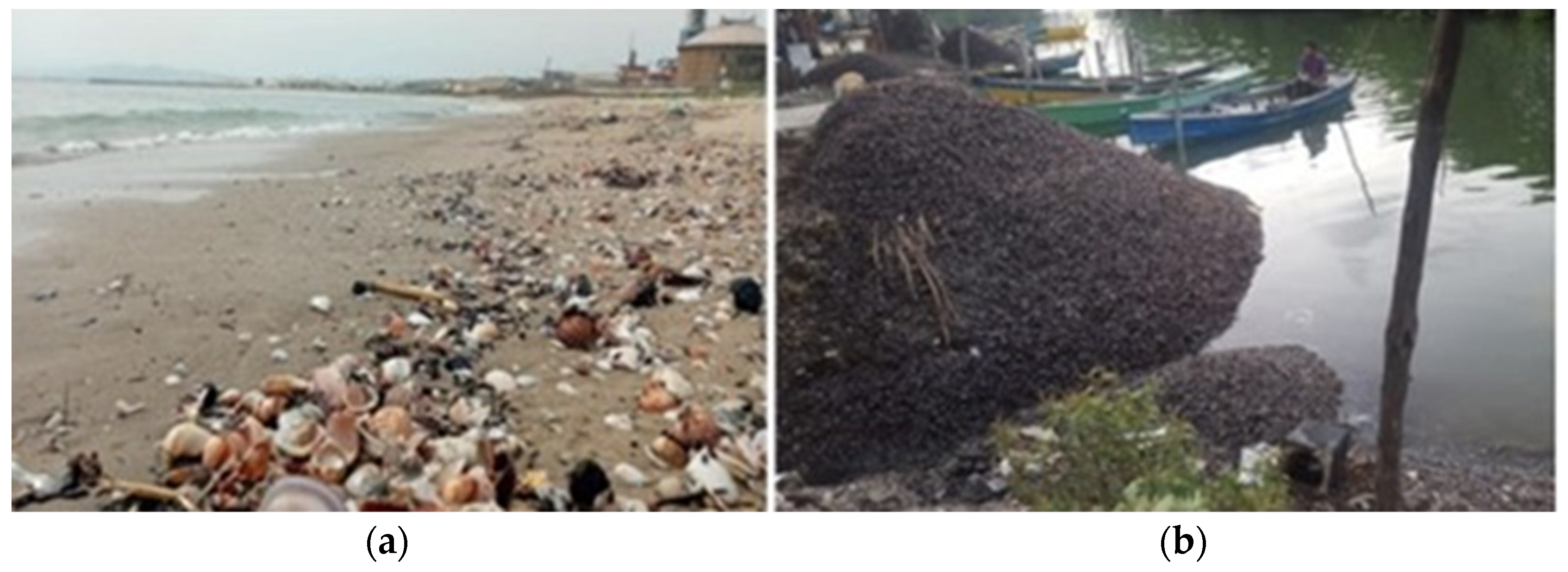




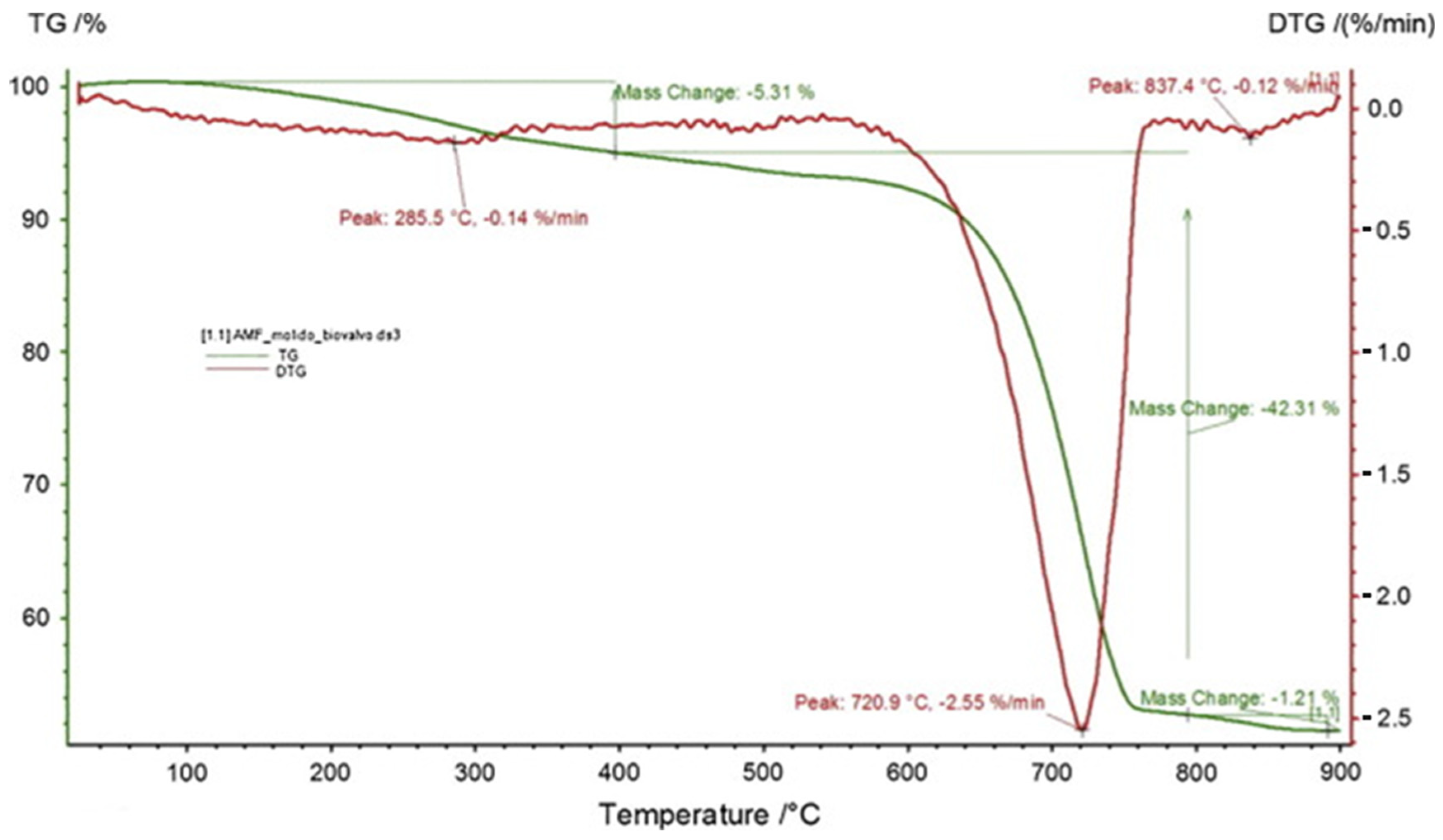
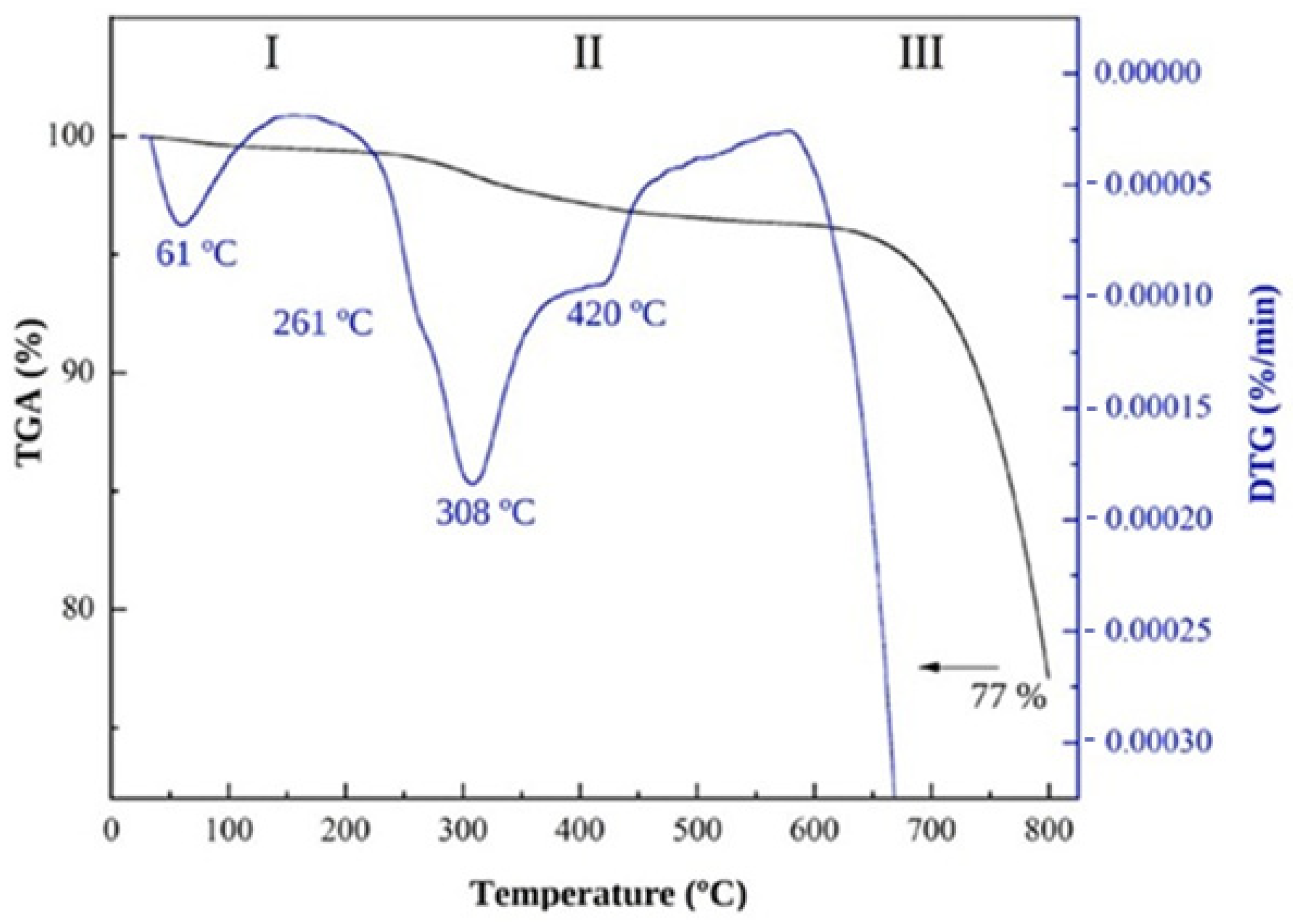

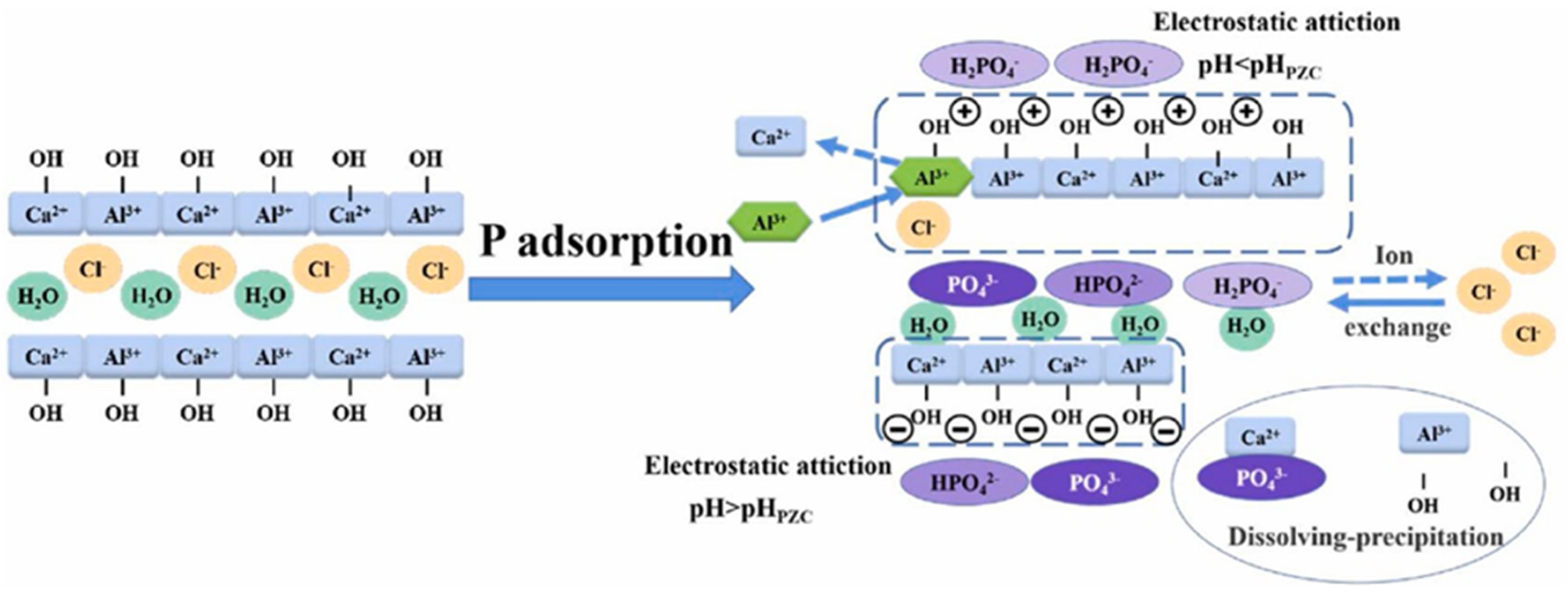



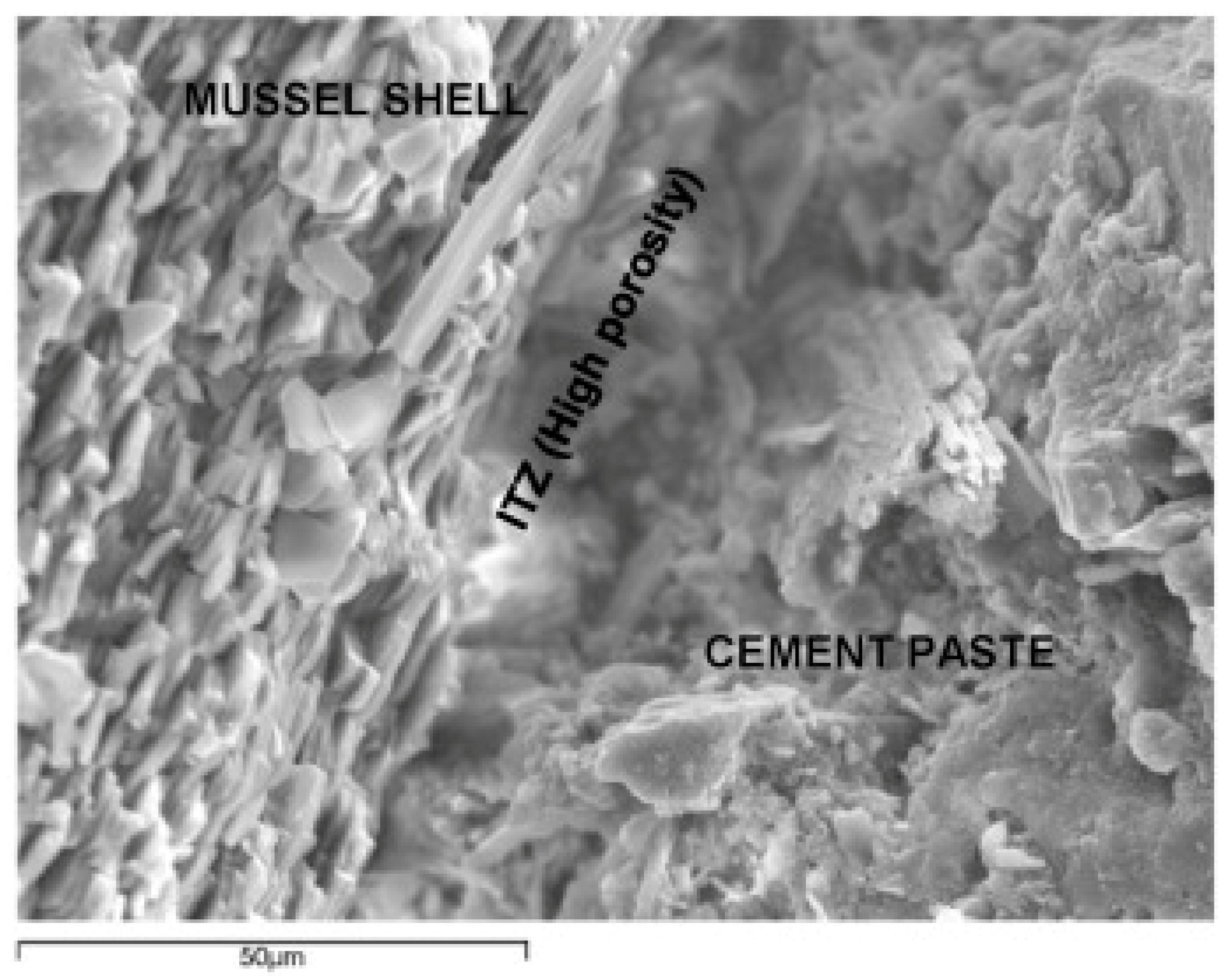
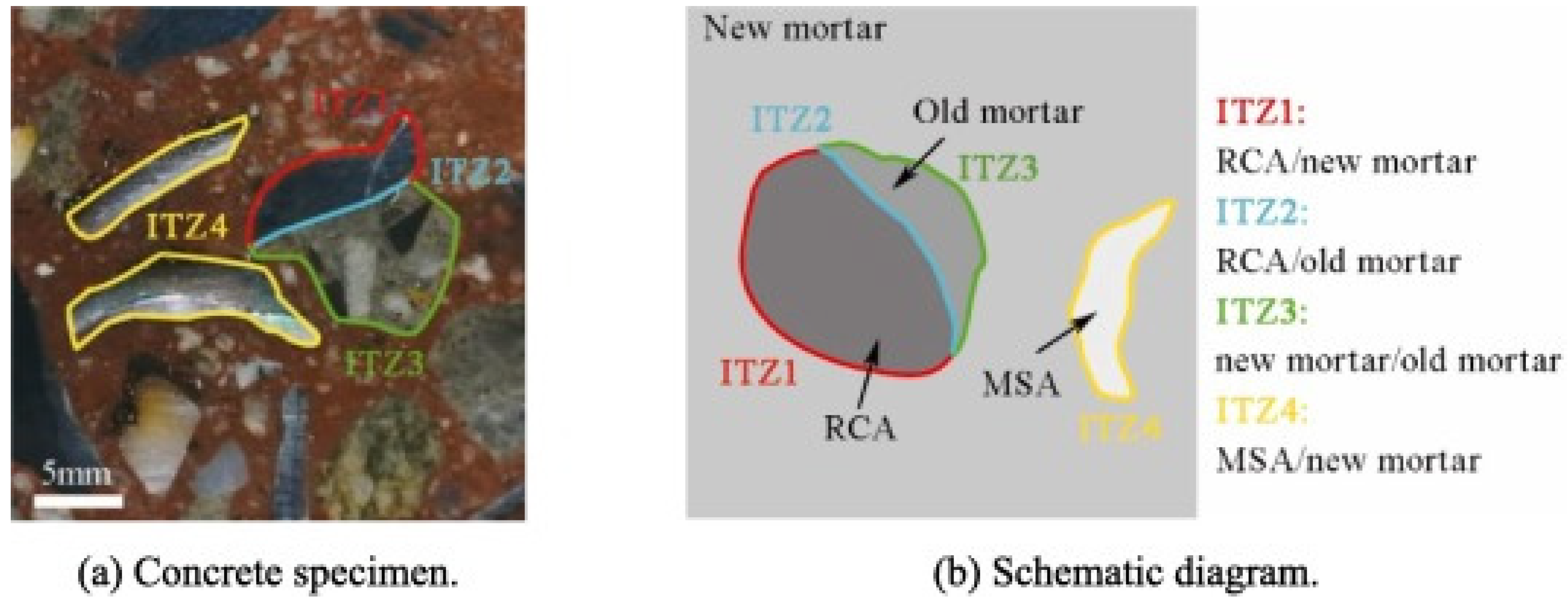
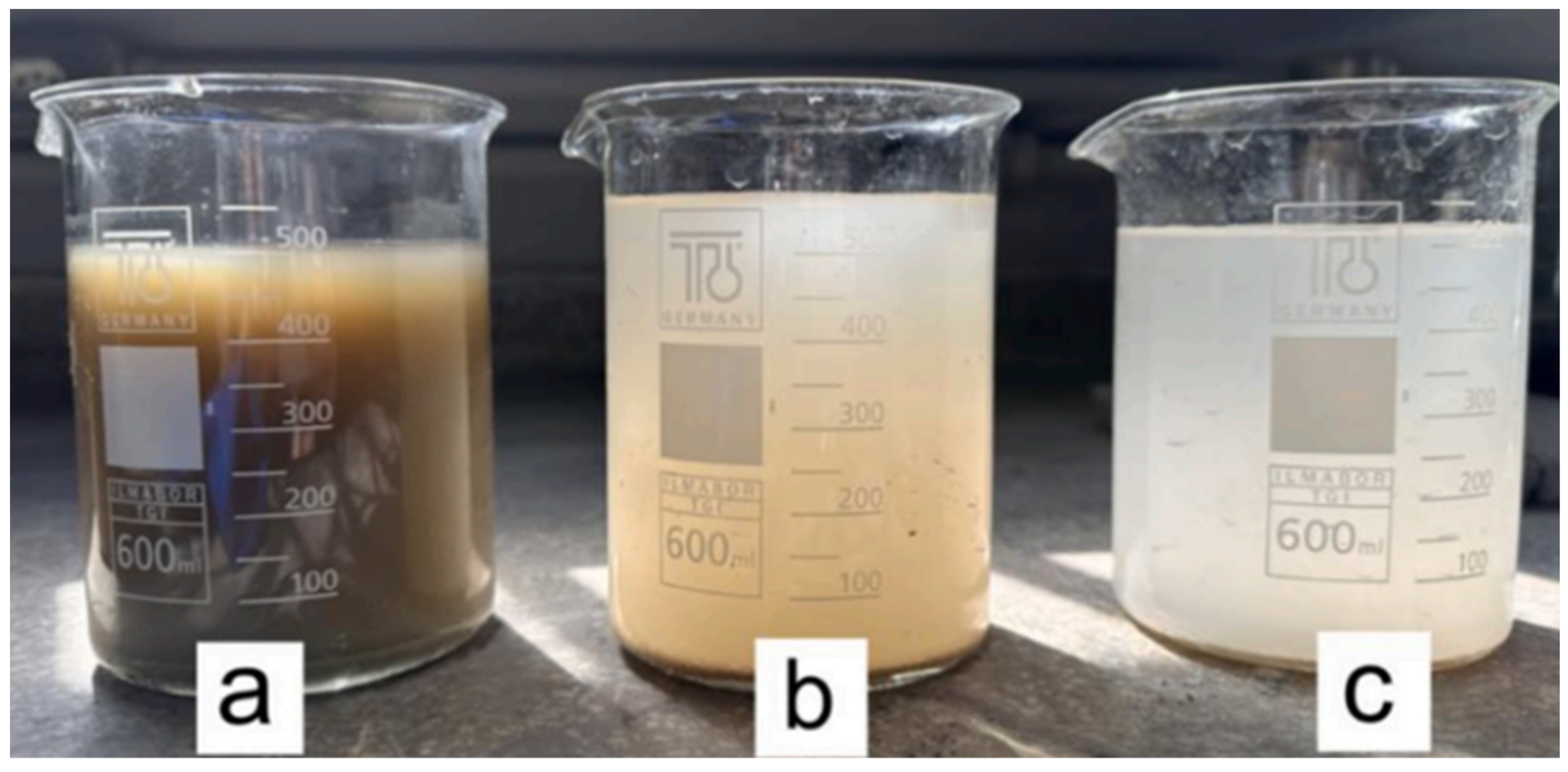

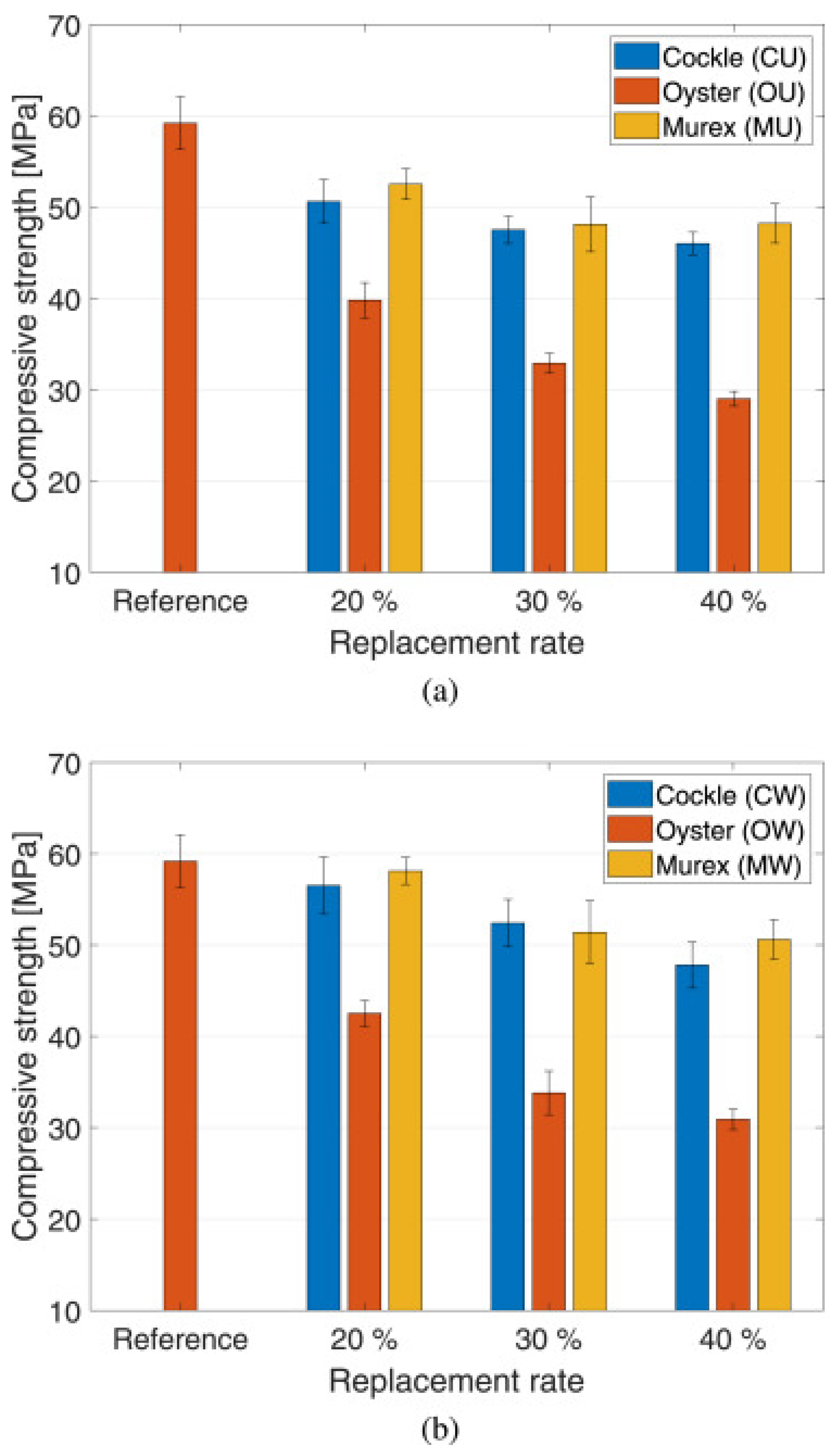
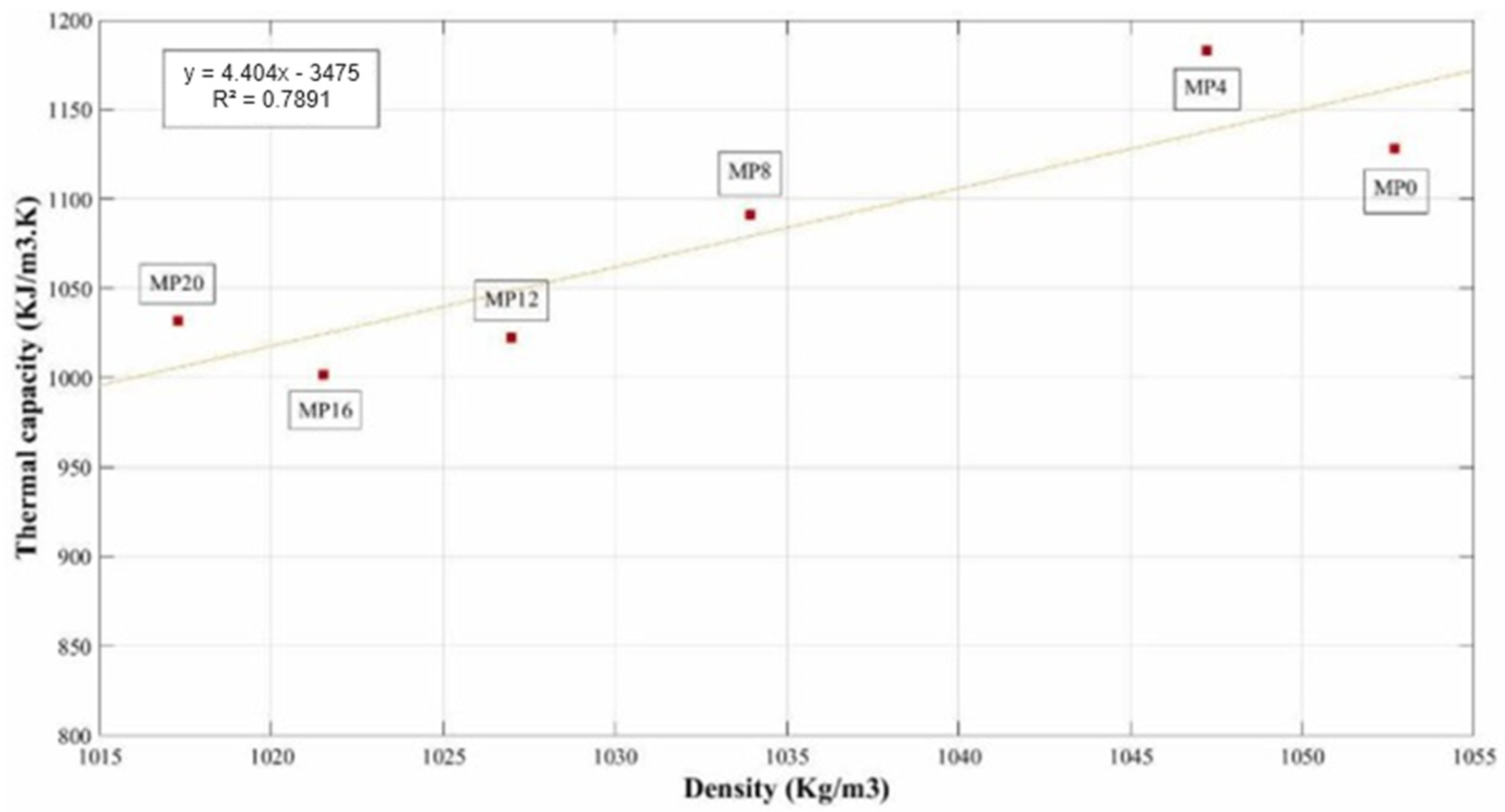
| Year | Publications |
|---|---|
| 1963–2000 | 8 |
| 2001–2010 | 11 |
| 2011–2020 | 48 |
| 2021–2024 | 37 |
Disclaimer/Publisher’s Note: The statements, opinions and data contained in all publications are solely those of the individual author(s) and contributor(s) and not of MDPI and/or the editor(s). MDPI and/or the editor(s) disclaim responsibility for any injury to people or property resulting from any ideas, methods, instructions or products referred to in the content. |
© 2024 by the authors. Licensee MDPI, Basel, Switzerland. This article is an open access article distributed under the terms and conditions of the Creative Commons Attribution (CC BY) license (https://creativecommons.org/licenses/by/4.0/).
Share and Cite
de Freitas, J.J.G.; Vieira, C.M.F.; Natalli, J.F.; Lavander, H.D.; de Azevedo, A.R.G.; Marvila, M.T. Cleaner Production of Cementitious Materials Containing Bioaggregates Based on Mussel Shells: A Review. Sustainability 2024, 16, 5577. https://doi.org/10.3390/su16135577
de Freitas JJG, Vieira CMF, Natalli JF, Lavander HD, de Azevedo ARG, Marvila MT. Cleaner Production of Cementitious Materials Containing Bioaggregates Based on Mussel Shells: A Review. Sustainability. 2024; 16(13):5577. https://doi.org/10.3390/su16135577
Chicago/Turabian Stylede Freitas, José Júlio Garcia, Carlos Maurício Fontes Vieira, Juliana Fadini Natalli, Henrique David Lavander, Afonso Rangel Garcez de Azevedo, and Markssuel Teixeira Marvila. 2024. "Cleaner Production of Cementitious Materials Containing Bioaggregates Based on Mussel Shells: A Review" Sustainability 16, no. 13: 5577. https://doi.org/10.3390/su16135577
APA Stylede Freitas, J. J. G., Vieira, C. M. F., Natalli, J. F., Lavander, H. D., de Azevedo, A. R. G., & Marvila, M. T. (2024). Cleaner Production of Cementitious Materials Containing Bioaggregates Based on Mussel Shells: A Review. Sustainability, 16(13), 5577. https://doi.org/10.3390/su16135577







